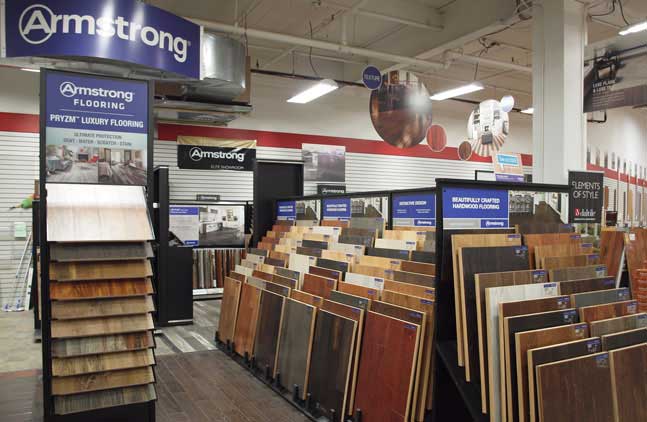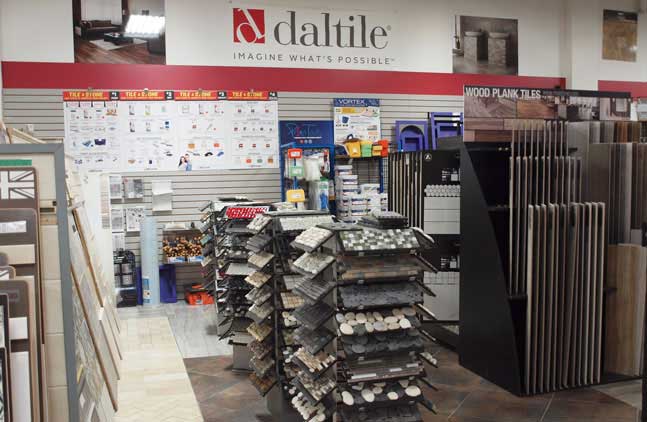Sprucing up your home's interior with new tiles can be an exciting way to invigorate the style of your home. Whether you're looking to add flair with a colorful kitchen backsplash or you need functional, easy-to-maintain flooring for your busy home, adding tiles to your room can be a great solution.
However, picking out tiles for your space may feel overwhelming if you're just starting out. Understanding which tiles work best for your room is challenging with so many options available.
There is no doubt that choosing the right tiles takes a lot of consideration. Whether you need floor or wall tiles, you need to consider the size, style, color, and material of the tiles before you make a decision. We'll go over the main considerations you should think about before you begin shopping so you pick out the perfect tile for even the tiniest room of your home.
Think About the Overall Style and Size of the Room
Not only do you need to think about the tile itself, but you also need to consider the room. Depending on the space and the purpose of the tile, you may have additional things to consider.
For example, when choosing bathroom or kitchen tiles, you need to think about the materials carefully. Marble tends to stain easily. So in places like the shower or behind the oven, natural stones don't hold up well over time as they become discolored easily.
Though it's important to think about functional considerations, tiles can also alter the overall aesthetics of the room. Light-colored tiles will help to open up a space, making it brighter and airier. Conversely, dark-colored tiles work well in larger spaces. So if you're working with a small space, like a tiny bathroom, then you might want to consider light-colored wall tiles to make your room feel bigger.
You should consider the style of your room before you install your tile. It's difficult and expensive to replace tile, so you should double-check that you won't get tired of the color, pattern, or material. While it's easy to repaint the room, certain features, like the flooring and cabinet fixtures, aren't as easily changed. It's often better to go with a neutral or classic look rather than a flashy one when it comes to tile so that it fits into the overall style of the room.
The size of the room can also affect your budget. If you're looking to tile an entire living room floor versus a small backsplash in your bathroom, you'll need to consider your options carefully. While you may be able to afford an expensive style of tile for a small place, when you're covering a large area, you may need to go with a more affordable and durable option.
Floor Vs. Wall Tiles
There's a difference between floor and wall tiles that you'll need to be aware of before you begin shopping. Floor tiles are made out of tougher materials and glaze that can withstand foot traffic. In contrast, wall tiles are much more delicate and are often made out of glass or other thin materials. Wall tiles are also smoother, so when they get wet, they're much more slippery than floor tiles. While you could potentially use floor tiles on the wall, you can't use wall tiles on the floor.
If you're seeking tiles for your floor, then you'll need to consider the size of the room. Large spaces, like living rooms, work well with large-sized tiles. Smaller rooms that don't have a lot of floor space, like the bathroom or kitchen, can work with smaller-sized tiles if you prefer that style more than the large ones.
The Different Kinds of Tiles Available
There are a few different types of tiles available. Depending on which room of your home you want to tile, there are specific materials that work best.
Ceramic
Ceramic is a type of tile made out of clay that has been put through a kiln. Ceramic is often used in kitchen tiles as it's strong, easy to clean, doesn't absorb odors or stains, and can handle extreme temperatures. Because of these advantages, you can use them as kitchen or bathroom tiles as a backsplash, countertop, or floor.
Ceramic tiles are one of the most DIY-friendly options on this list, as the stone is durable but still relatively easy to cut. It is also priced affordably, so making a mistake wouldn't be the end of the world.
Ceramic tiles are highly versatile, so going with this glossy white option would be a safe choice. The neutral color ensures that it will likely go with the aesthetic of the rest of the room. Even if you decide to swap furniture or paint your cabinets, you won't have to worry about replacing the tile. It's also a good choice for small spaces, the gloss combined with the white color enlarges the appearance of the room. So if you're remodeling your small bathroom, opting for a glossy, light-colored wall tile will make the room appear larger than it actually is.
Porcelain
Porcelain tiles are similar to ceramic tiles, but they are more durable and strong. They are made in the same fashion as ceramic tiles, except heated to higher temperatures, which makes them harder. If you're looking for a floor tile that can hold up under a lot of foot traffic, then porcelain is a good option. Additionally, glazed porcelain tiles are even more durable and resistant to damage and water. These features make porcelain a good choice for laundry room tiles or utility room tiles, as they'll be able to withstand a lot of wear and tear over the years.
If you're looking for laundry room tiles, this patterned floor tile may be a good option for you. The pattern offers an interesting design for a small space, like a laundry room or bathroom. These rooms typically don't have a lot of other options for decor, so the patterned tile is likely to work without clashing with other style elements of the room.
Marble
Marble is a natural stone known for its beauty and high price tag. It's not as durable as ceramic or porcelain tiles, as it is softer and more porous. Because of its lack of durability, marble tiles are typically not used in high-traffic areas or places where stains commonly occur. So unless your marble has been sealed, you shouldn't use it in the kitchen. Instead, you may want to opt for marble tiles around your fireplace or as bathroom tiles.
While ceramic tiles are a good option for DIY enthusiasts or beginners, marble is best left to professional installers. It's super easy to break, plus it requires specialized cutting tools. Not to mention, making a mistake installing marble tiles is going to be an expensive one, as this stone is pricey.
Glass Tiles
Glass tiles are great wall tiles, as they are resistant to stains, moisture, mold, and mildew. Because of their durability and functionality, they are commonly used as bathroom tiles and kitchen tiles.
Though they're super durable, many people are drawn to glass because of its smooth and glossy appearance. They can come in a wide range of colors, patterns, and shapes. This glass tile has the appearance of marble without any of the natural marble stone's disadvantages, like being easily stained. So, if you like the appearance of marble but want to install it in the kitchen or shower, this glass option is the best alternative.
Limestone
This natural stone has a rustic, earthy appearance, which makes it great for living room tiles around the fireplace. It also looks great as hallway tiles around doors and entryways. However, because it's one of the more delicate tile stone options available, it doesn't work well in the kitchen or laundry room. It's easily scratched, plus drinks can stain it.
Despite not being durable, many people gravitate towards limestone because they are after that natural stone look without the high price tag. Limestone is one of the most affordable natural stones available, especially compared to marble. So, if you are looking for natural stone to add some elegance to your room but you're on a budget, limestone is a good choice. Just be careful about where you place it within your home to preserve its appearance.
Travertine
Travertine is a type of limestone that can be found in beige or light brown colors. This natural stone is textured and organic, so it has an earthy appearance that many people seek in tiles. Much like other types of limestone, it's highly porous, so it's best not to install it in places likely to see a lot of spills. It's commonly used as living room tiles since it looks great around the fireplace. People have also used it in their bathrooms, though travertine does take extra care to clean and maintain it.
This travertine stone tile would work great as an accent tile in your living room or entryway. Its neutral color and natural appearance work well with a variety of styles, so you can potentially use it in other parts of your home too.
Consider the Maintenance
It's important to think about the maintenance of any tile you choose, especially floor and shower tiles, as you will have to clean these often. The best easy-to-clean options are porcelain and ceramic tiles, as they resist stains and moisture pretty well. These types of tiles are also not easy to scratch, so they hold up well under a lot of use and traffic.
How to Choose Tiles for Different Rooms
Overall, when you go to pick out a tile for a room, you first need to think practically about it. You'll need to choose tiles that can withstand the traffic, use, and moisture that a room will receive.
Living Rooms
To choose tiles for a living room, you'll need to think about where they'll be going. Living rooms typically receive a lot of foot traffic, so you'll need to go with a durable and easy-to-clean tile option, like porcelain. However, if you're planning to use the tiles as wall or fireplace accents, you won't have to worry about durability quite as much.
Bathrooms
If you're looking for tile to use in the bathroom, you'll need ones that are easily cleaned and moisture-resistant. Glass tiles are a great choice for shower walls, while porcelain or ceramic can work on the backsplash or floor.
Kitchens
The main concern when picking out backsplash tiles for the kitchen is stain resistance. With cooking splatters, spills, and messes, the tile in the kitchen has to be cleaned easily and quickly without stains ruining its appearance. Ceramic, porcelain, and glass are all the best choices for the kitchen, as they're strong enough to handle any cooking that goes on in the room.
Laundry Rooms and Utility Rooms
For rooms that see a lot of messes, you'll need a floor that can be easily cleaned and maintained. Laundry room tiles and utility room tiles will see a lot of moisture and potentially messy situations. Porcelain is a great floor tile that can ensure easy cleanup if water gets spilled or dirt gets tracked onto it.
Overall, going with durable tiles that can be easily maintained for years is a safe way to ensure that you won't have to worry about costly replacements. Also, choosing classic neutral colors or traditional patterns is a great plan to ensure that the tile will always fit the aesthetics of the room. So, if you're after the most affordable and versatile option, porcelain and ceramic tiles are some of the most popular options due to their durability and beautiful appearance. If you're ready to browse for room tiles, we have a lot of ceramic and porcelain floor and wall tile options in a variety of colors, some of which even mimic the look of natural stones.














